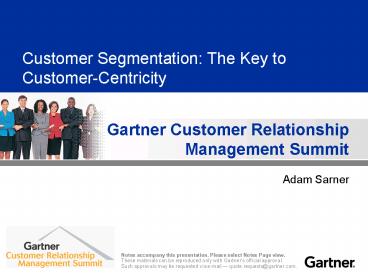Customer Segmentation: The Key to Customer-Centricity - PowerPoint PPT Presentation
1 / 19
Title: Customer Segmentation: The Key to Customer-Centricity
1
Customer Segmentation The Key to
Customer-Centricity
- Adam Sarner
2
The Essence of CRM
Value Proposition
Customer Profitability
Customer Satisfaction
" the customer never buys what the supplier
sells. What is value to the customer is always
something quite different from what is value or
quality to the supplier."
Peter Drucker Management Challenges for the 21st
Century
3
Client Issues
- How is the basis of customer segmentation
evolving? - How do you build useful customer segments?
- How do you use segmentation to raise customer
value?
4
Corporate View of Segmentation
Variable
Fixed
Value
Location
Channel
Industry
Purchases
Size
Tenure
Typical criteria in B2B, other criteria relevant
in both B2B and B2C
5
Customer View of Segmentation
Customer Wants
Customer Needs
6
The Basis of Segmentation Corporate Value or
Customer Need?
"Corporate" Segmentation
"Customer" Segmentation
7
What Drives Customer Behavior?
Self-Segmentation Surveys
Demographics Psychographics
Interactions Transactions
8
Who Is the Customer?
The Customer
Your Competitor's Customer
Today's Customer
Your Customer
Your Customer
9
Defining the Customer Relationship
Frequency
Customer Activity
Value
Recency
Time
10
Creative Tension in Alternative Approaches
Starting with an understanding of the market and
brand ...
Starting with transaction and (maybe) demographic
data ...
Marketing identifies logical segments ...
Business analysts identify clusters ...
that marketing attempts to understand.
that the business analysts match to behavior.
11
Criteria for Segmentation Schemes
Accuracy
Differentiation
Does this segment really behave in a consistent
manner?
Does this segment have different needs than other
segments?
Complexity
Feasibility
Are the needs of this segment intuitively
understandable?
Can the information be collected to create and
manage this segment?
12
Customer Segments at Sainsbury's Grocery Stores
"Quality Oriented" 49
"Family- Oriented" 25
Organics
Time Poor Cash Rich
"Foodies"
Health-Conscious
"Low Contribution" 26
Source Adapted from Sainsbury
13
Case Study A U.S. Software Company
Low Persistence
High Persistence
New Customers
Prospects
High Current High Potential
Retention,recognition, cross-sell
Welcome, thank you, growth
Retention, Recognition
Acquisition/ reactivation
High Current Low Potential
Retention Recognition
Retention
Welcome thank you
Low Current High Potential
Loyalty/growth (cross-sell, upsell)
Welcome growth
Investment based on 50 per customer/prospect
Potential Value (in millions)
Low Current Low Potential
Low priority/investment
Acquisition Upsell Upsell Upsell/Cross-sell U
psell/Cross-sell Upsell/Cross-sell Retention
7.5
2.27
1.13
Marketing Opportunity
1.05
.67
.53
.23
14
Building Customer Portfolios
15
Raising Revenue From Matching Products and
Customer Segments
Follow evolution of customers to new segment
Redefinition of product's value proposition
New
Customer Segment
Product bundling for increasing penetration
Develop new products to expand relationship
Existing
New
Existing
Product
16
Lowering the Cost to Support Customer Segments
Level of Satisfaction
Importance to Customer
17
The Life Stage Evolution of Customers Through
Segments
Perpetual Single
Young Affluent
No Kids
Couples
Retirees
Families
Empty Nesters
Students
Teens
18
Segment Hopping
19
Recommendations
- Strategic segmentation schemes should be based on
fixed criteria that will provide guidance on how
to improve the relationship, not variable
criteria that measure the success of the
relationship so far. - Segmentation schemes based on a combination of
needs, wants and actions build a more-complete
view of the relationship than schemes based on
only one or two dimensions. - Using segmentation schemes to improve customer
value should be done at both a segment (treatment
rules) and individual (migration) level.































